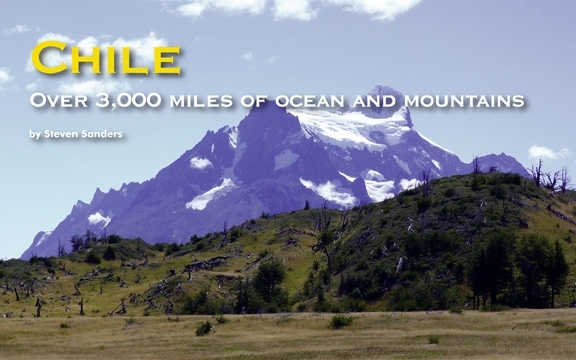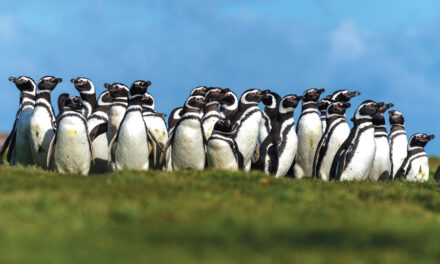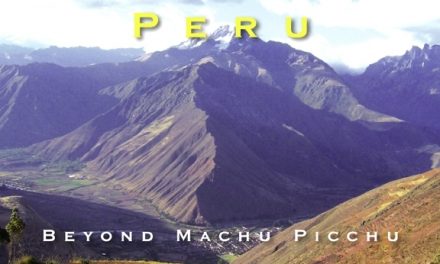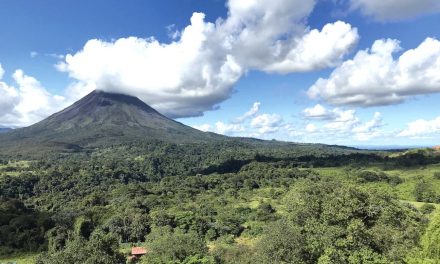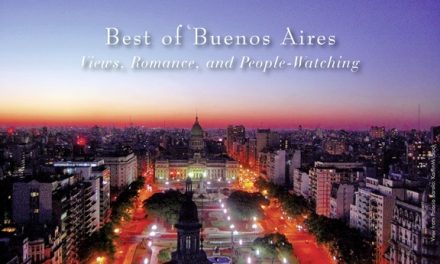Chile
Over 3,000 miles of ocean and mountains
by Steven Sanders 
Chile’s great outdoors attracts the adventurist; the cities challenge the ambitious; its wine region soothes the simplistic; its desert absorbs the purist. In short, Chile attracts, and can certainly attract all.
After arriving in Chile’s sprawling capital city Santiago, almost in the very centre of the world’s longest north to south country, my first task was to decide between desert or ice – a choice very few countries can offer year round. I chose to put these options on hold and first explored the country’s charming central valley, taking in South America’s most modern city, the country’s wine region, and the cosmopolitan coast.
Santiago
While many South American cities have long possessed that unique buzz, the feeling in Santiago is different. This is a new buzz which replaces the old. Negativity and pessimism are almost non-existent; instead café culture, live music, and street festivals are taking over. With one of the world’s most stable economies, Latin America’s most thriving nation is on roll, and Santiago is spearheading the assault.
The best place to start in the city is the centre. Many of the locals will argue that this area is chaotic, run down and noisy, and while the latter two points have improved dramatically over past few years, it is being amongst the chaos of el centro that will help you capture the atmosphere of Santiago’s working class while exploring the country’s past through its many museums and colonial buildings. Dating back to the 1540’s, Plaza de Armas is the heartbeat of el centro, and is located at the very centre of Santiago’s initial layout. Here you can find one of Santiago’s last remaining colonial buildings, the Casa Rosada, which is home to the Museum of Santiago, as well as the nearby Catedral de Santiago and the Iglesia de Santo Domingo. The Plaza is surrounded by inviting cafes, restaurants, and street vendors, and a morning spent exploring this area is recommended before further exploring the city.
The View from Above
Just a ten minute walk will take you to Barrio Bellavista, one of Santiago’s most popular nightlife spots – particularly among expats and travelers. A harmless night-out here will do no harm, however it is the area’s daytime activities that attract almost all of Santiago’s visitors. Bellavista sits at the foot of Cerro San Cristobal, the city’s second highest point. Ascending via the funicular – or ascensor – tourists spend an afternoon or sunset taking in the city’s most coveted view, with the looming Andes mountain range providing a breathtaking backdrop. Along with the food and ice cream options at the summit, there is also a cute church with a statue of the Virgin Mary overlooking the city. At the foot of Cerro San Cristobal is the Santiago Metropolitan Zoo, which houses many animals unique to South America, and can be a great place for both adults and kids alike.
Venturing away from Santiago’s centre, jazz fans should head to Club de Jazz in the barrio of Ñuñoa, while those looking for a bit of retail therapy can browse the numerous malls in the green, tree lined district of Las Condes.
Coastal Art
Heading 127 km (79 mi) west by road takes you from mountains to ocean, and crossing over half of the width of spindly Chile. Here along the Central Valley coast waits Valparaíso and Viña del Mar, two contrasting cities set just 8 km (5 mi) apart. I spend my first day exploring Valparaíso’s colourful and rugged streets, with an almost constant view of the Pacific Ocean peering around the stacked up buildings and streets at every opportunity. Once the most important port in South America and now declared a UNESCO World Heritage Site, the city known as Valpo is now heavily reliant on tourism, with around 50 cruise ships calling at the city’s port during the Chilean summer, as well as being the transport point for Chile’s in demand copper, wine, and fish.
Often referred to as Little San Francisco, Valparaíso’s colourful street graffiti is simply remarkable, and a whole afternoon can be spent wandering the streets around the old quarter just marvelling at the reality and emotion that screams out from many of the city’s walls. Taking one of the now world famous funiculars is a must, so I make sure to take this to Ascensor Artilleria, to capture a memorable view of the city. Valparaíso is also said to be home to Chile’s famous Cueca dance, and there are many options throughout the city where one can spend the night learning some new moves.
During the summer months between December and March, the beachfront city of Viña del Mar – known locally as Viña – becomes host to many Chileans from the nearby regions, who come to enjoy the sun, sea, and sand, as well as to try their luck at Chile’s biggest and oldest casino. I took the advice of a local and rented a bicycle near Reñaca beach, before cycling along the scenic, 12km seaside road of Constanera.
Wine and Empanadas
Chile is the world’s fifth largest exporter of wine – particularly red – and just over an hour south of Santiago, the dusty yet charming town of Santa Cruz, nestled within the Colchagua Valley, is the perfect place to explore Chile’s increasingly popular wine region. We stayed at the Hotel Santa Cruz, which offers a casino and some fine dining, but the real experience is at the city’s tiny cafés and restaurants, which offer some of the country’s best and most authentic empanadas, as well as the chance to interact with the locals who describe themselves as ‘real Chileans’. If an afternoon sampling Chile’s famous wine isn’t enough, Santa Cruz also offers horseback riding around the local scenery, and is also home to Chile’s largest private museum, the Museo de Colchagua.
Beach Hopping
‘Here you can take a two week vacation and visit a different beach every day.’ This was the sound advice from a local who greeted me at the coastal city of La Serena, in Chile’s Small North region, something I later discovered was a common saying in these parts. Chile’s second oldest city offers some of the country’s best and freshest seafood, and offers a slower pace of life surrounded by remarkable scenery and fresh air. Time spent here should be as the locals do, whom you can engage with at the La Recova Municipal Market whilst bartering over hand-made crafts. La Serena is also a perfect base for the stunning Valle del Elqui, which offers some top trekking with a view.
Desert Country
In the far north, San Pedro de Atacama is one of Chile’s major tourist hotspots – for those who can reach it. Daily flights do operate between Santiago and the nearby city of Calama, and once here you can visit the world’s driest desert, the Atacama, before spending the evening in awe watching the night unfold below the clearest skies in the world. Some of the most important space observatories in the world are located in this region due to the constant clear skies, with many offering tours of their telescopes and facilities. After exploring San Pedro de Atacama’s charms, I spent a long morning at the nearby El Tatio Geysers, which is home to the world’s third largest geyser field as well as some relaxing, tranquil mud baths.
Patagonia
The sole mention of the word Patagonia to me drew images of colliding glaciers and jagged ice fields surrounded by a fiery volcanic landscape. While my mind did wander a little, I certainly wasn’t far off, and the mere site of the region from the cross country flight window was enough to get even the most seasoned outdoor enthusiasts excited. Patagonia will challenge you one minute, and embrace you the next, but no matter what your emotions, it’s hard to look past how beautiful this part of the world really is. Turquoise lakes linger, as if frozen in time below the inconsistent yet brilliant snow-capped mountain ranges. On a clear day, Patagonia’s wild is simply breathtaking.
While the local communes of Puerto Natales and Punta Arenas will do all they can to accommodate tourists, this is not a region for cities. You can take a bus from Puerto Natales to one of the world’s most spectacular hikes at Torres del Paine National Park. The hike is open to all levels, and there are various kinds of accommodation, from camping and refugios to strategically located hostels and hotels.
The W trek took five days at a slow pace, and can realistically be done in three, however with so much to see and explore, many take between four to eight days to take everything in.
What you should know
Chile is a country of startling contrasts, and your suitcase and daypacks should be prepared for this at all times. During the summer months (December-March), bring mainly light clothing and one set of clothes for a typical winter day. Sunscreen will be needed year round in the northern regions, and while temperatures in the Atacama can soar to 30 degrees Celsius during the summer, a huge drop at night is normal, with below freezing temperatures not uncommon. The same can be said for Torres del Paine, which can also experience big temperature swings during the long days of the summer. Winter clothes and layers are a must for this region at any time of year, however temperatures can warm up suddenly when the skies are clear.

